
| Volume 30 #4 | January/February 2014 | |

For some reason, I'm reminded of a line from a stand-up comic giving a show at the Naval Academy many years ago. At one point, he imitated an intercom message broadcast from the bridge of the ship:
"Now hear this! now hear this! This is the Captain speaking:
"That is all."
No idea where that came from.
So, here we are: halfway through the year, but also at the end of one year and the beginning of another. In the year just ending, we had a very successful October dance with many dancing friends joining us from all points of the compass; and at the very end of December, we will have (or have just had, depending upon when you read this) the year-end Betwixt-n-Between dance, coordinated by Ken Dewire with lots of help from Susan Shaw and Teacher Liza Halpenny.
This year also saw an addition to the many classes we hold in Southwest Washington: Marge's Style and Technique of Country Dance 101 class has been very well attended since it began in the Fall.
A big, bright spot in our Spring will be our Dinner Dance on April 26th. This event is being very enthusiastically chaired this year by Katie and Bryan Jones. Their enthusiasm and joy is incredibly infectious, so if you have any time to help out, just check with them so see what you can do. "Many hands make lighter work"... PLUS you get to smile a lot while you're doing it!
Adding to our dancing pleasures are the dances, workshops, and classes sponsored by Branches (ours and others!) all over the Pacific Northwest: Burns Celebrations in Seattle in January and in Eugene in February, the Portland workshop and Ball in March, the Heather Ball in Seattle... Ah, so many dances, so little time!
I love this time of year.
This is an account from one of our dancers who is now living in Spain and teaching English. Note, each description in the article goes sequentially with each photo in the table below, left to right and top to bottom and when you hover the pointer over the image, a balloon appears giving a description of the image. ~ The Editor
Lugo is an old Roman city in Galicia. It is famous for its full Roman wall. I'm in the Obligitory Tourist Photo with the only two remaining arches.
My coordinator explained that in most places Roman walls were slowly dismantled as their stones were taken for other building projects. Most were knocked down in the 1950s to make more room for expanding cities. But Lugo's wall was saved because it was still mostly intact and thus too expensive to demolish! It used to have arches all around the wall, but now only two remain.
Notice the blue and yellow shell to the left to mark the path for the Camino de Santiago. Lugo is along the route.
This statue is on the same facade. He's San Froilan, the patron saint of Lugo. He's also connected to animals, and veterinarians. Very appropriate, since there's a veterinary school attached to the University of Santiago's Lugo campus.
Another Obligitory Tourist Photo: Me standing between the Romans who are founding Lugo. The one on the left is holding a model of the city wall in his hand. They're life-size; they're maybe as tall as I am? This is located in Lugo's Plaza Mayor.
Here is the remains of a Roman bath. There are random glass-covered Roman ruins around the city. Unfortunately, the glass tends to fog up in the rain, about 70% of the time, and then you can't see what's inside!
This is one of the drop boxes for mail at the Lugo post office inside the walls. You drop the mail into the lion's mouth.
A view of Lugo from the top of the wall. There's a very nice path along the wall, lots of people stroll or jog along it.
My desk in my room. I share a 4 bedroom apartment with three Spaniards. Two are from Galicia, but the third is from Extremadura. We share puzzled looks when the others speak in Gallego.
The neighbor across the way has a cat, who I occasionally get to watch looking around frantically for things to kill.
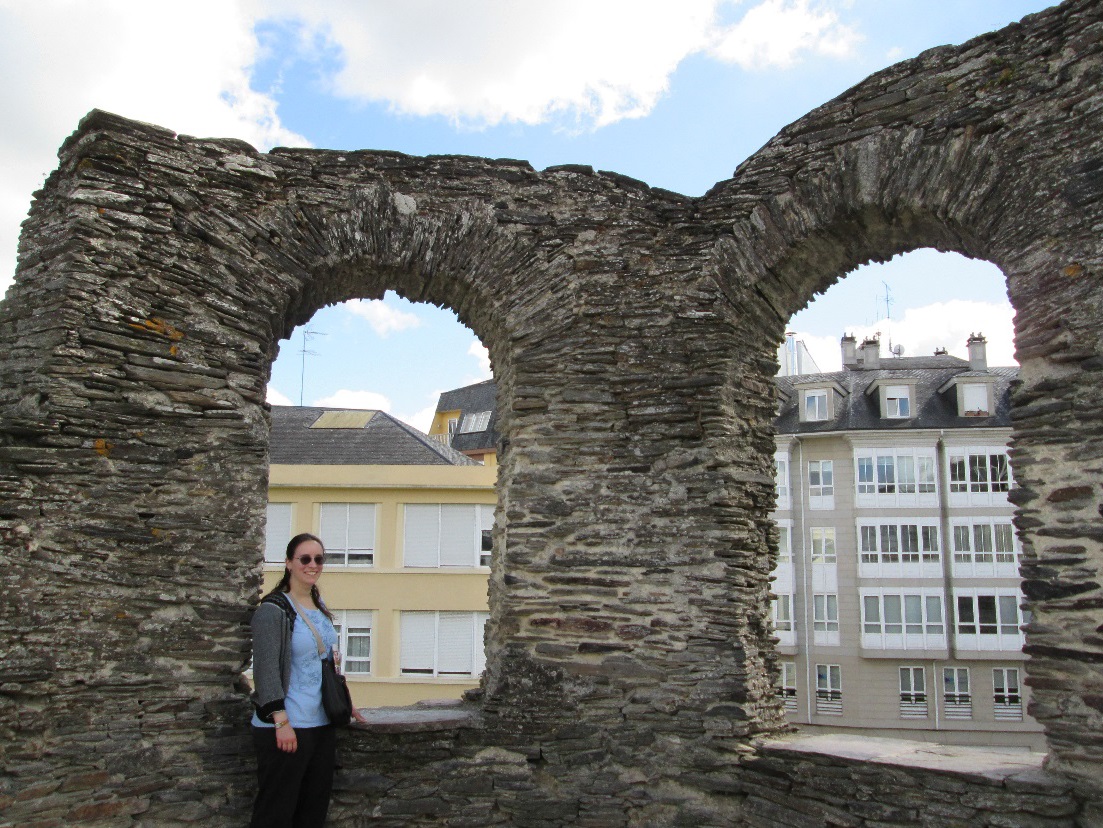
|
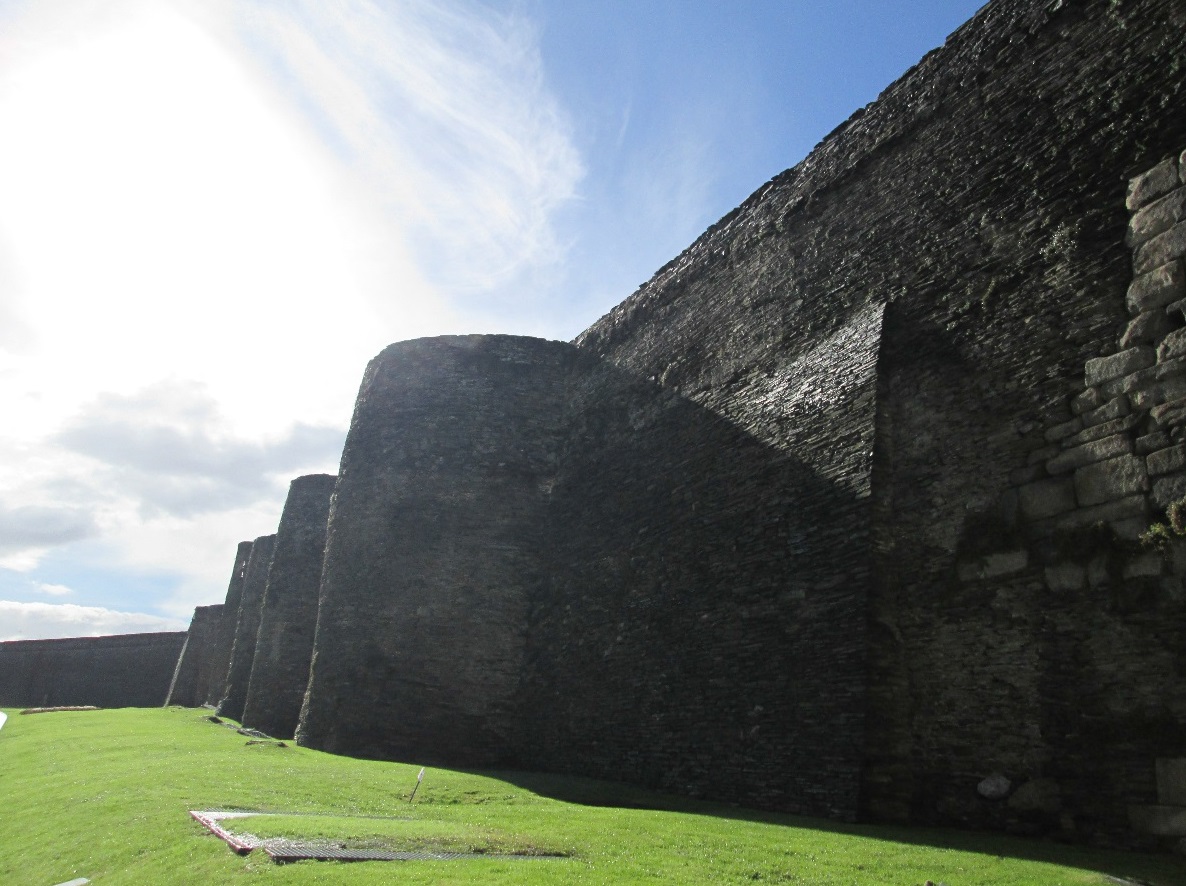
|
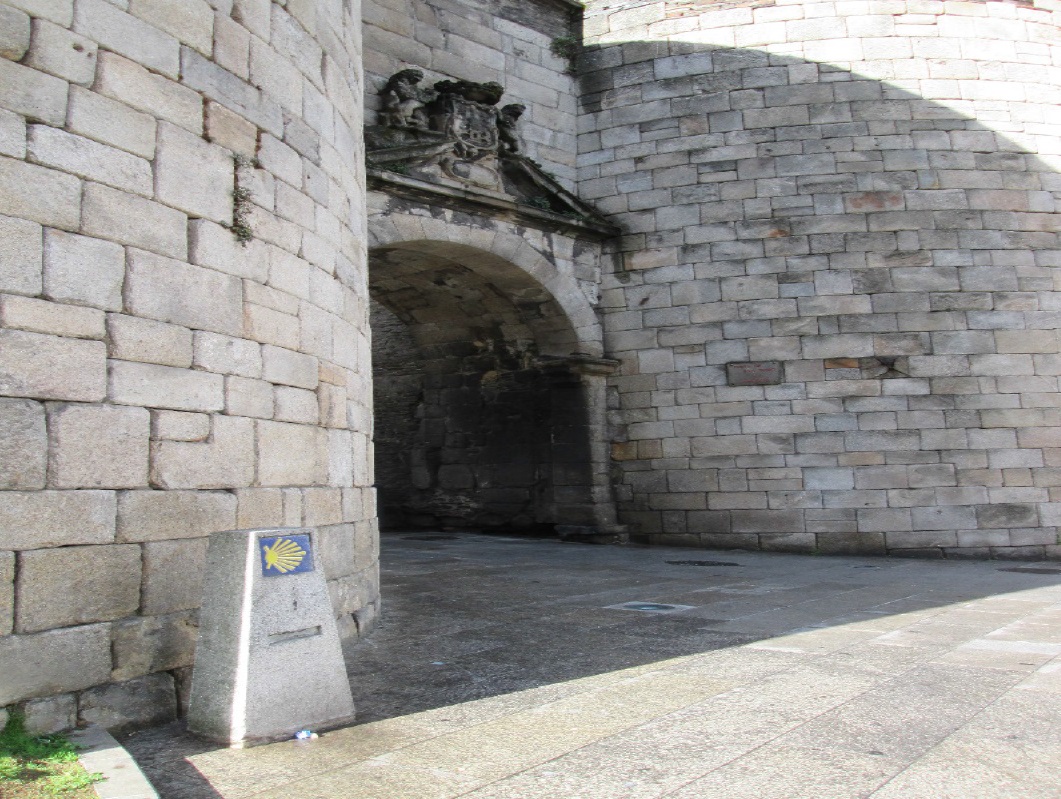
|
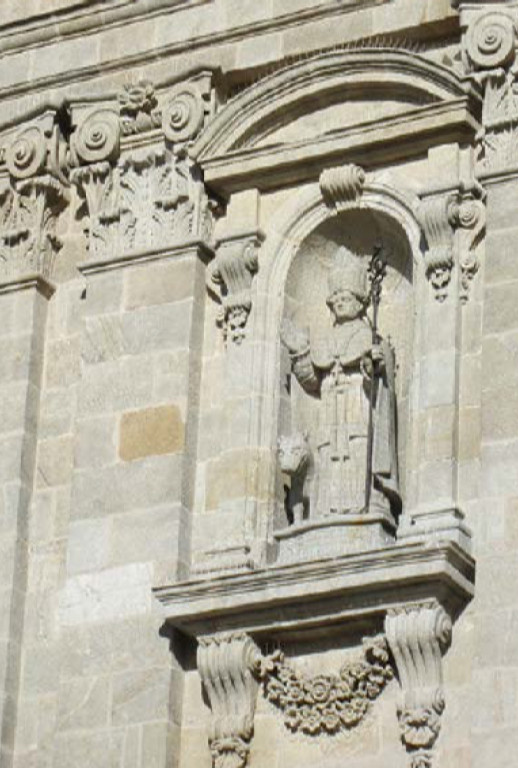
|
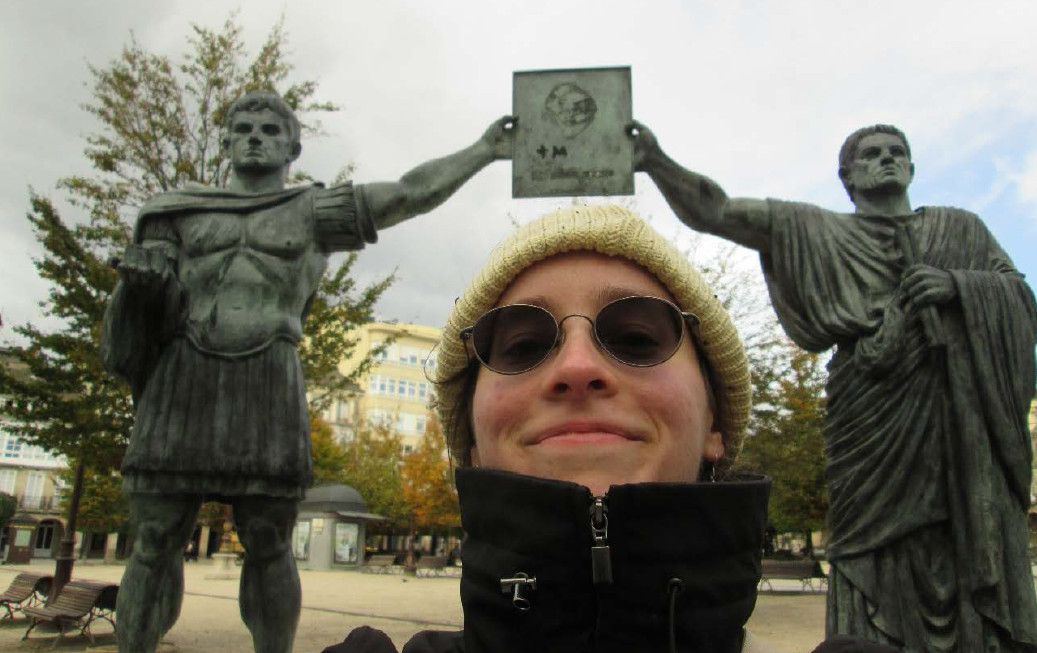
|
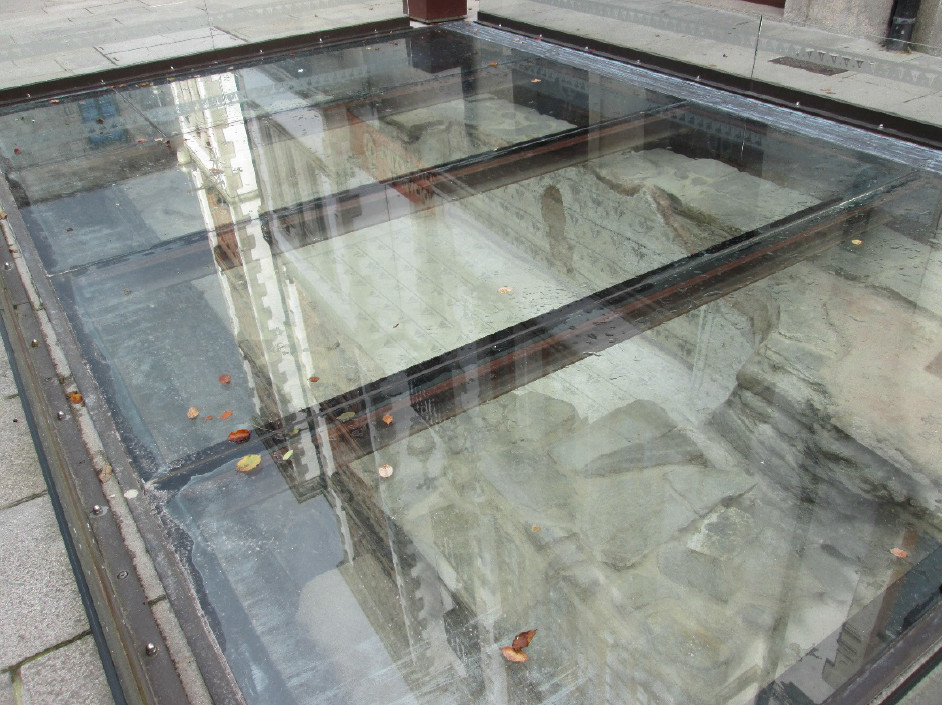
|
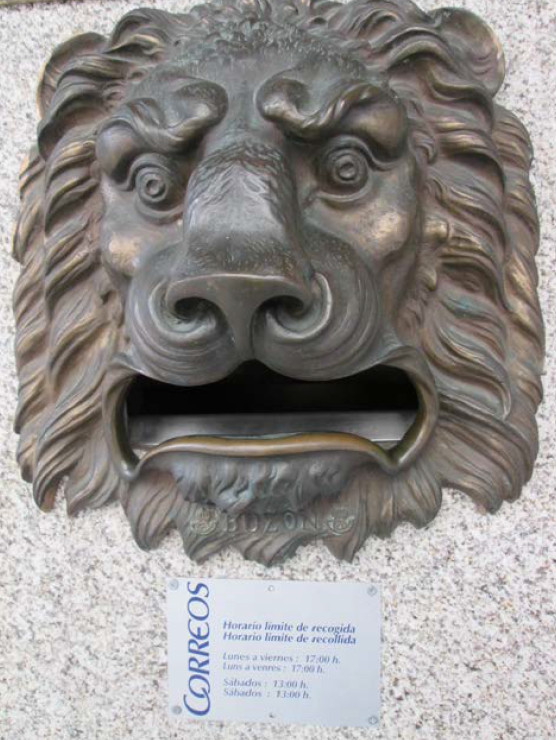
|
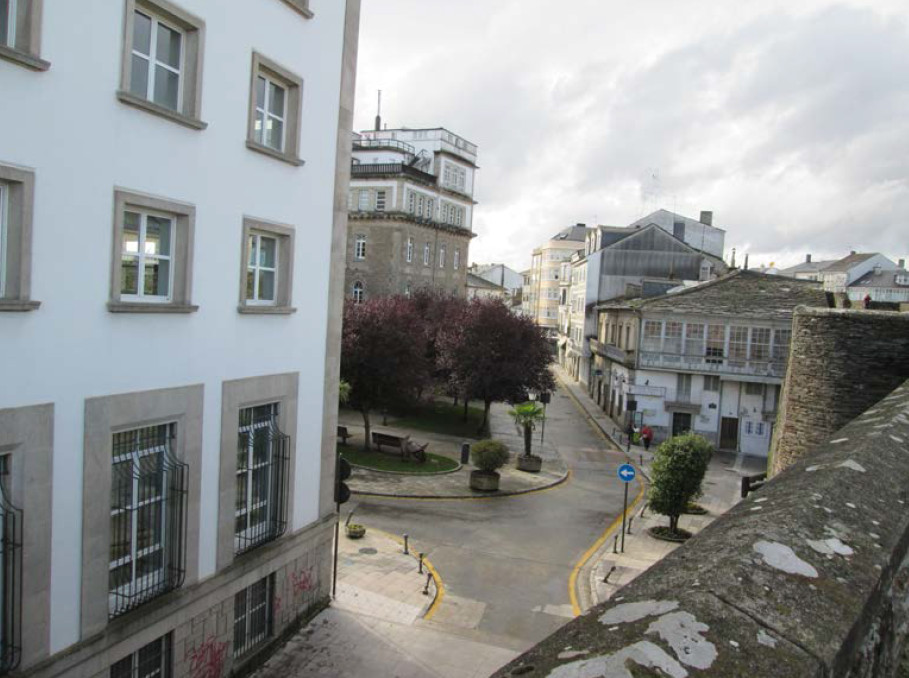
|
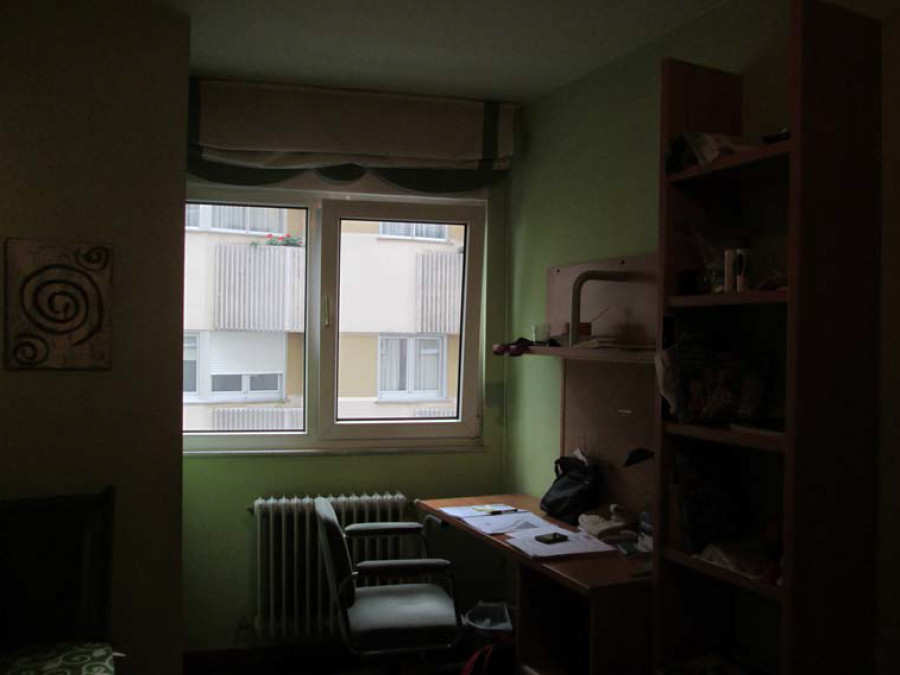
|
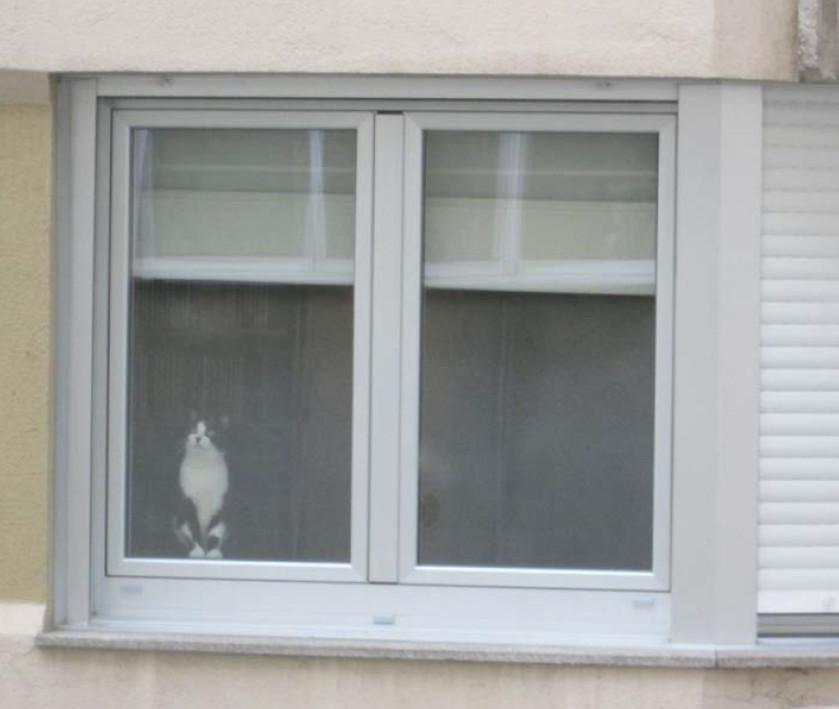
|
From his book Scotland Through her Country Dances and reprinted in the New Brunswick Scottish—Cultural magazine, Sept '92 issue. If you can obtain a copy of George's book, do so, as it is a fascinating tour through Scotland via ScDancing! In the late 15th century, the family of Groat of Dutch or Flemish origin obtained land in the district of Duncansby in the northernmost tip of Scotland. John de Groat was very probably sent by the King, as tradition has it, to take charge of the ferry which plied twelve miles across the dangerous currents of the Pentland Firth to Orkney. This ferry, indeed, appears at one time to have belonged to the Crown.
It is not really known which John O' Groat built the house or inn referred to by some travelers in the 17th century as the most northerly house in Scotland. The Rev. John Brand visited John O' Groats and stayed overnight in the famous house in 1898. He tells us that the landing place was called John O' Groats House. "It is the northernmost house in Scotland; the man who now liveth in it and keepeth an inn there is called John Grot, who sayeth this house hath been in the possession of his predecessors of that name for sore hundreds of years; which name of Grot is frequent in Caithness. Upon the sand of John Groat's house are found many small pleasant buckies and shells, beautified with diverse colours, which some use to put upon a string of beads, and account much of their rarity. It is also observed of these shells that not one can be found altogether like another, and upon the review of the parcel I had discovered some difference among them, which variety renders them the more beautiful. "
From an article published in the Boston RSCDS Branch, 1992 ~ The Editor
A one-hour program titled "Scottish Country Dancing: Controlled Abandon", celebrating 90 years of the RSCDS, was broadcast by BBC Scotland on December 29th. We can visit the website to view a preview and example dance clips. http://www.bbc.co.uk/programmes/b03mtrg9/
RSCDS is organizing a global Commonwealth Ceilidh for June 21, 2014, in its partnership role with the "Get Scotland Dancing" campaign to get more people regularly participating in dance activity. RSCDS will create a two-hour dancing program to include three new dances along with guidance on how to organize and run a mass Commonwealth Ceilidh. We can visit the website to learn more: http://getscotlanddancing.org/the-commonwealth-ceilidh
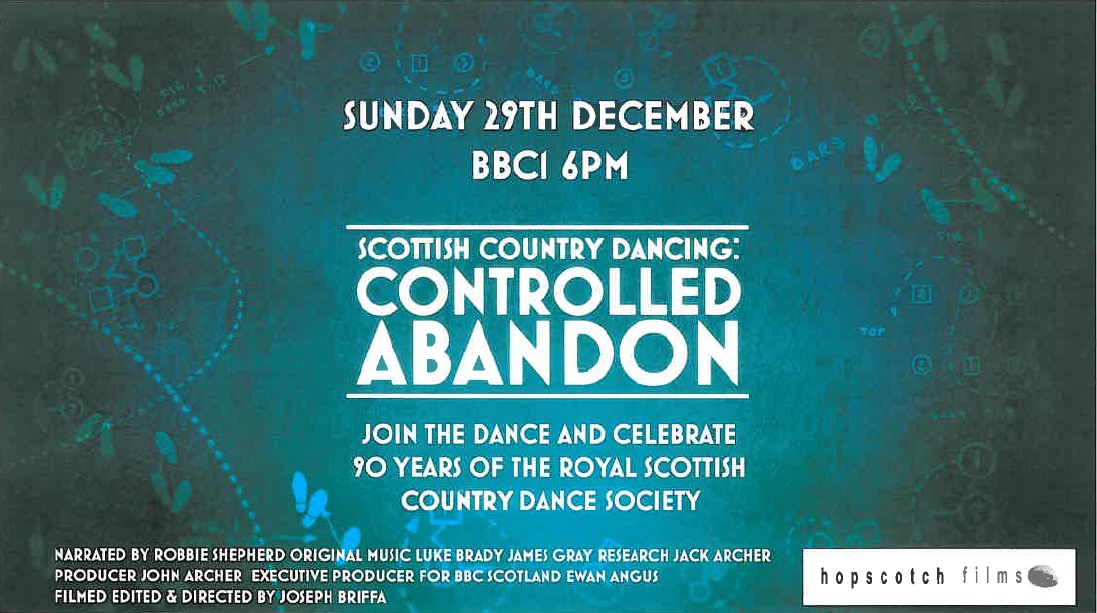
Throughout dance history every era has had its own known-at-the-time terminology. Below are some Early 19th Century Dance Instructions taken from a SCD book published in 1830; exerpted here from The Tartan Times (Boston), 2004.
Reel of Six
Place the ladies the same as in the Reel of Five, and two Gentlemen in the centre. The Gentlemen with the first and third Ladies form a reel of four, during which, and when the two Ladies are crossing together, the other two ladies cross over and cross back; when the first two ladies are in the middle, all set, the Gentlemen turning to the ladies alternately. They then reel with the other two ladies, and set as before.
Reel of Eight
Place as in the quadrilles, eight hands round and back again, set to partners, double hands across, back again, and set to the right and left all eight and set. Double reel by the promenade, and repeat the figures.
Waterloo Reel
Reel across and set, promenade round the room; if there are more reels than one, the couples follow each other with the promenade in one great circle.
Fourteen years ago, I wrote an article on reforestation of the Scottish Highlands for The Ghillie Gazette. I thought it would be interesting to catch up on the status of this large scale ecological restoration project.
The rugged Scottish Highlands were once covered by what the Romans called the "Caledonian Forest." Caledonia ("wooded heights") formed the western outpost of Europe's boreal forest: a vast mosaic of Scots pine, birch, aspen, willow, alder, rowan, juniper, elm, ash and oak trees. It was Scotland's equivalent of our temperate rainforest here in the Pacific Northwest.
About 2,000 years ago, the deforestation began. Trees were cut for fuel and timber and to convert the land to agriculture. The widespread introduction of sheep and huge increases in the number of red deer ensured that once the forest was cleared, it would not return.
The Highlands have been described as a "wet desert" as a result of centuries of exploitation that have reduced them to their present impoverished and barren condition.
By the start of the 21st century, less than one percent of the original forest survived, reduced to 35 isolated remnant stands of native woodland, most occupying less than 25 acres each.
Large scale restoration began in earnest in 1989 when Trees for Life was established with the vision to restore Scotland's ancient Caledonian Forest to a spectacular wilderness region of 1,000 square miles of mountains and glens west of Inverness and Loch Ness.
Since then, Trees for Life has become Scotland's leading conservation charity, with volunteers planting more than one million trees. It has created 10,000 acres of new Caledonian Forest across 45 locations in the project area. The scattered, irregular distribution of the planted trees, and those that have regenerated naturally, have all the appearance of a natural forest, and mosses, bog myrtle and other plants have colonized the peat hags (areas of exposed peat with pine stumps visible in them).
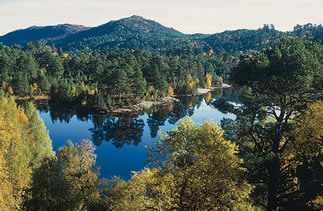
The majority of forest restoration work is carried out by volunteers, with hundreds of people joining from all over the world every year to plant trees and conduct other conservation work. Trees for Life has set an ambitious target of planting its second million trees in just five years.
Dundreggan, in Glen Moriston near Loch Ness, is the flagship restoration project. Trees for Life purchased the 10,000-acre estate in 2008 in one of the largest land purchases in the UK specifically for forest restoration. Dundreggan contains substantial areas of ancient woodlands, including remnants of the original Caledonian Forest, superb birch-juniper woodlands and the largest expanse of dwarf birch in Scotland. Dundreggan has been described as a "lost world of biodiversity," with many rare species from the colorful strawberry spider to the endangered black grouse.
To learn more, visit the Trees for Life website at http://www.treesforlife.org.uk
Scottish dance friends celebrated the holidays with the Betwixt and Between dance and ceilidh.
Martin, Eunice, and Layne read stories and poems in English and Gaelic. Linda Mae, Caitlin, and Lilyana performed a dance and action poem. Heather sang, "I Could Have Danced All Night."
We danced the winning Branch dance for the RSCDS Book 49 submission, titled "Scatter Creek", by Marge van Nus, a 32-bar strathspey for four couples.
We enjoyed everyone's company during the social time with holiday goodies. Thanks to dance chair Ken Dewire and to Liza Halpenny who led the dancing. Thank you all for coming to the dance, and Happy Holidays!

|
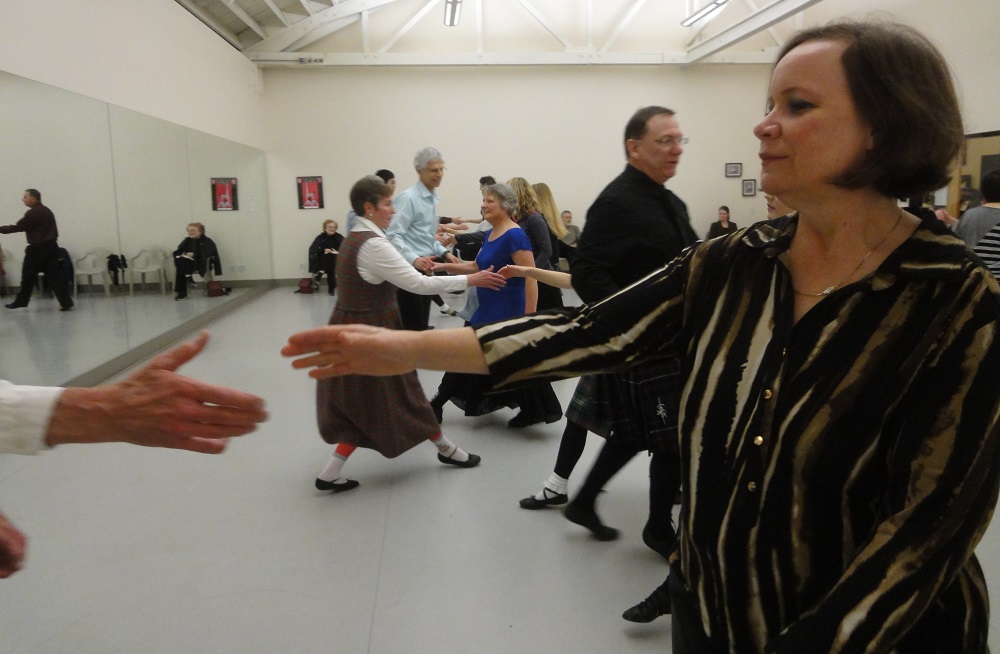
|
As I spent the Christmas holidays sick at home while the rest of my family went on family visits outside the home, I had the opportunity through the magic of a Sony Blue-Ray player given to us by my son David and his girlfriend Caitie, to enjoy some interesting programming through the agency of additional ability to receive video streams from online video services such as YouTube(tm) and Vimeo(tm) amongst others.
I have been enjoying that feature since it was installed, especially as I'm a fan of documentaries, especially those from the BBC. This last week, as I'm interested in rail travel, I found a series that is presented by Michael Portillo, a retired British politician, Cabinet Minister, with apparent fluency in at least five languages that I've been able to detect, and journalist who now is a presenter at the BBC. He is also half Scottish whose mother and father were from Kirkaldy near Fife in the east of Scotland. More about this fascinating fellow can be found here at http://en.wikipedia.org/wiki/Michael_Portillo
One of the two video series he was a presenter in was Great Continental Railway Journeys. One of these is a journey between Copenhagen, Denmark and Oslo, Norway with a little stop in Gothenburg, Sweden. There, it turns out, has long been connections between Scotland and Sweden, particularly the city of Gothenburg. However, lest I spoil the surprise and the connection between us and our avocation specifically, direct your browsers to http://www.youtube.com/watch?v=xf8nsShqWcw and slide the progress bar to 33:00 and enjoy.
I began learning Square dance five years ago, after Scottish dancing for the previous twelve years. The club caller and dance teacher Jim Hattrick explains his main goal for Square dance lessons is to get dancers to "move to the beat of the music." Jim's popular teaching methods regularly attract 70 club members and new dancers to his weekly lessons in a friendly social setting. Moving to the beat of the music, while having fun with friends, sends a message of positive feelings to the limbic brain.
This year I expanded my interest to explore Irish Ceili dance, English Country dance, Contra dance, and International Folk dance. I had an opportunity to observe how all these folk dance forms approach teaching dancers to move to the beat of the music.
Teachers of all dance forms guide dancers among the actions:
1. Dance while moving to the beat of the music
2. Move to learn the pattern to the music or leader's count
3. Stand and observe others move to learn the pattern to the music or leader's count
4. Stand and listen to the leader talking
An effective dance teacher strikes a balance among the necessary actions, with the goal to spend as much time as possible on action number one.
I originally observed that Square dance has more continuous motion compared with Scottish dance. The caller announces the next move just in time for dancers to flow through the dance figures. On the other hand, Scottish dance motion with the skip-change step is twice as fast as walking, and the pas-de-basque setting step is more aerobic, so we need resting time between bursts of energy.
After I learned Square dance, I became sensitive to standing while learning a Scottish dance. Geoffrey Selling discussed the topic in a TACTalk article, "Why Aren't We Attracting More Dancers to Scottish Country Dancing? (especially from the greater dance community)". The article explains how teaching a Scottish dance can involve excessive standing and surprisingly little dancing, compared with English Country dance's greater motion. http://www.rscds-swws.org/news/tac/WhyArentWe.pdf
Since I practice several folk dance forms, I designed an experiment to measure the percentage of time I am moving during various dance activities. I have a goal to keep moving, and I have been wearing a pedometer for three years to measure my progress. In addition to measuring steps, my current pedometer measures "Activity Time". The timer runs while I am moving and pauses when I am inactive. I use a stopwatch to record the elapsed time during a dance or a dance class and I also record the activity time. I reset the activity timer and start the stopwatch after sets have formed and the dance leader begins teaching or briefing a dance, and stop the stopwatch after the final chord of the dance. I pause the stopwatch when some unavoidable technical delay or unrelated reason occurs. The ratio of activity time to elapsed time gives the percentage of time I was moving:
Activity Time Percentage = Activity Time ÷ Elapsed Time x 100
I gathered activity data for 72 dancing events over 16 weeks. Most of the data was for Scottish dance (52 hours) and Square dance (35 hours), and I made an effort to get a sense of activity for other folk dance forms. We can view my Average Activity Time Percentage results in the chart. The Square dance "Dance" activity led with 86%, and the "Class" activity averaged 60% when the caller taught the moves. The Scottish dance "Dance" activity averaged 51%, and the "Class" activity averaged 38% for teaching dances. English Country dance averaged 52%. Other folk dance forms averaged in the 61-73% range.
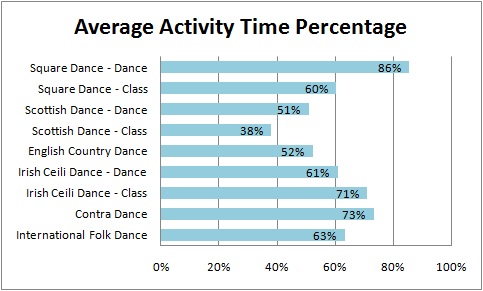
The activity time measurement excludes the intensity of physical activity and interest level, so we need to interpret the results. After each dancing event, I subjectively noted whether the event gave me a positive, neutral, or negative interest level. I observed a strong correlation between Activity Time Percentage and interest level. Most dance events were positive, however there were a significant number of Scottish dance classes with neutral or negative interest, especially classes with excessive standing and less listening to the beautiful music. All Scottish dance "Dances" were positive. Irish Ceili dance and Contra dance have the quality of being both aerobic and high Activity Time Percentage. Square dancers move to the beat of the music with walking steps, and I am able to increase the walking energy with more spring in my steps and travel the moves with a slightly longer path.
The Scottish dance class Activity Time Percentage averaged 38% with a range of 30-53%. Dance classes with a value greater than 40% were generally positive interest, while less than 40% gave me a neutral or negative interest level. I wonder how much Scottish dance class interest and attendance would improve if teachers could consistently raise the Activity Time Percentage above 40%, with a focus on moving to the beat of the music.
This article finally explains to fellow dancers and dance teachers who have been curious about the numbers I have been writing on Post-it notes while dancing. Interested readers can contact me to view the spreadsheet file with the activity time data. I would like to thank my dance teacher friends for your skilled and entertaining teaching efforts.
Calendar of Events | |||||||||||||||||||||||||||||||||||||||||||||||||||||||||||||||||||||||||||||||||||||||||||||||||||||||||||||||||||||||||||||||||||||||||||||||||||||||||||||||||||||||||||||||||||||||||||||||||||||||||||||||||||||||||||||||||||||||||||||
|
|